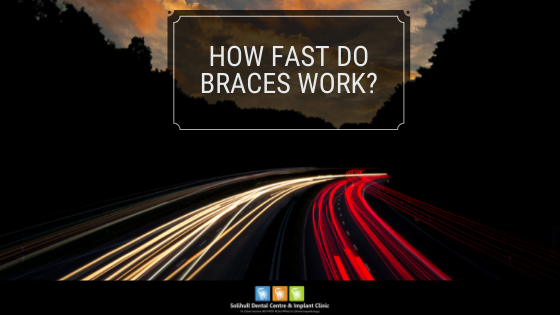Are you thinking about getting braces? You might be overwhelmed by the various braces available for orthodontic treatment. The selection of braces for your orthodontic treatment that offers the best aesthetic and functional results while fitting your budget can be a challenging task. Another factor to consider is the treatment time. Today, fast braces are available to treat tooth misalignment in a much shorter time than conventional metal braces.
If you are confused between selecting the conventional or fast braces and would like to know more about the pros and cons of each, then read on. This article offers an overview of different types of braces and will help you choose an orthodontic system that best suits your dental needs.
How Long Will It Take For Braces To Straighten My Teeth?
Orthodontic treatment often works faster if we are only moving the front 6 teeth, often called the ‘social six’ – This is because the roots of front teeth are smaller than the roots of the back teeth and so can be moved much faster.
The estimated time required for fixing an orthodontic problem depends on three main factors:
- The severity of the orthodontic problem
- The type of braces or orthodontic system used
- Patient compliance
According to the British Orthodontic society, minor tooth problems involving the front six teeth can be treated as early as six months with traditional braces. However, more complicated issues involving the bite may take longer – anywhere between 12-24 months – for complete treatment.
There is another option for people who do not want to wait that long- the fast braces. As the name suggests, these braces fix tooth misalignment in a shorter duration compared with conventional metal braces. According to the manufacturer, fast braces can take anywhere between three months and a year to treat orthodontic problems. Again, that would depend on the severity of your problem and how well you adhere to your dentist’s instructions.
Why Do My Teeth Feel Loose With Braces?
To realign your teeth, your dentist has to move them or reposition them. Since the roots of our teeth are embedded in the bone, your orthodontist has to exert pressure on the roots to move them. During this process, the bone around the roots is removed to allow for the movement of the tooth.
This is why you may feel that your teeth have become loose during orthodontic treatment. However, there is no need to worry; as soon as the tooth movement stops, bone tissue forms around the root, anchoring it firmly within the jawbone.
What Will Happen If Braces Move Your Teeth Too Fast?
Like other bones inside our body, the jawbone also undergoes remodelling when put under pressure. If too much force is applied to the teeth for faster movement, it will be directly transmitted to the underlying jawbone. As a result of this pressure, the jawbone starts to resorb, causing two problems.
First, bone resorption makes the teeth mobile in their sockets. Secondly, excessive pressure on the teeth can lead to the inflammation of the periodontal ligament – the tissue which suspends our teeth in their sockets, causing periodontal inflammation. That is why dentists apply gentle and controlled forces on the teeth during orthodontic treatment to ensure no adverse effects.
Fast Braces: Pros And Cons?
Fast Braces are an attractive treatment option for those looking for an orthodontic treatment option that works faster than traditional braces. But this is not their only benefit. Let us look at some of the disadvantages and benefits of Fast Braces.
- Pros of Fast Braces
- Less painful than conventional braces
- No or minimal need for tooth extractions
- Minimal changes in bite
- Fewer wires and adjustments needed compared with conventional braces- fewer orthodontic visits required.
- Cons of Fast Braces
- Not a “comprehesive” orthodontic treatment, with more emphasis on the “aesthetics” than the functionality
- Fast Braces may not be suitable for complex or complicated orthodontic problems.
Fast Braces Vs Regular Braces
Any type of orthodontic brace can be turned into fast braces. Therefore regular braces and fast braces are often the same thing. There are a few systems such as the Inman Aligner which allow very rapid movement of teeth in approximately 16 weeks, although Invisalign can also move teeth in up to 6 months if the conditions are right.
How Do Fast Braces Work?
According to the manufacturers of Fast Braces, these are low-profile orthodontic brackets that use flexible orthodontic wires to move the teeth quickly and without the need for using heavy forces. A distinct difference between the mechanism of the conventional braces and the Fast Braces orthodontic technology is that the traditional braces first move the roots and then the upper portion of the teeth.
In contrast, the Fast Braces are designed so that they move both the tooth root and the upper part of the teeth – the crown – at the same time. This is a significant reason why Fast Braces can fix front teeth problems shorter than the traditional fixed braces.
If you are confused between choosing conventional or Fast Braces, let an experienced and qualified dentist help you at your nearby dental practice.
At Solihull Dental and Implant Centre, we have a team of highly experienced dental professionals who will help you choose an orthodontic treatment option that offers the best aesthetic and functional results. We also take pride in having state-of-the-art dental diagnostic and therapeutic equipment to offer the highest quality dental services to our esteemed patients.
NO matter how fast you want your teeth to be straight, consider Invisalign aligners. We offer all orthodontic services under one roof. So, book an appointment with us and take your first step towards a healthy and beautiful smile – Fast!



